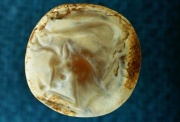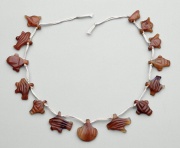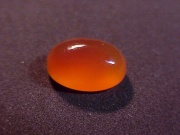Difference between revisions of "Carnelian"
Jump to navigation
Jump to search
| Line 3: | Line 3: | ||
A pale orange-red to deep red translucent stone that is a variety of [[chalcedony]]. Carnelian was mined or gathered as an ornamental stone since at least 3000 BCE. It is found in Egypt, India and areas of Europe as water-worn pebbles. Carnelian was popular for amulets and scarabs and is still used as gemstones. | A pale orange-red to deep red translucent stone that is a variety of [[chalcedony]]. Carnelian was mined or gathered as an ornamental stone since at least 3000 BCE. It is found in Egypt, India and areas of Europe as water-worn pebbles. Carnelian was popular for amulets and scarabs and is still used as gemstones. | ||
| − | [[File:35.1500-CR6505-d1.jpg|thumb|Carnelian | + | [[File:35.1500-CR6505-d1.jpg|thumb|Carnelian amulets<br>MFA# 35.1500]] |
== Synonyms and Related Terms == | == Synonyms and Related Terms == | ||
Revision as of 10:49, 28 August 2020
Description
A pale orange-red to deep red translucent stone that is a variety of Chalcedony. Carnelian was mined or gathered as an ornamental stone since at least 3000 BCE. It is found in Egypt, India and areas of Europe as water-worn pebbles. Carnelian was popular for amulets and scarabs and is still used as gemstones.
Synonyms and Related Terms
sard; cornelian; chalcedony; Karneol (Deut., Pol.); cornaline (Fr.); cornalina (Esp., Port.)
Physical and Chemical Properties
Trigonal crystal system Fracture = conchoidal. Luster = vitreous to waxy. Streak = white.
| Composition | SiO2 |
|---|---|
| Mohs Hardness | 7.0 |
| Density | 2.6 |
Comparisons
Properties of Common Gemstones
Resources and Citations
- Mineralogy Database: Quartz
- Encyclopedia Britannica, http://www.britannica.com Comment: "carnelian." Accessed 14 Sept. 2001 .
- C.W.Chesterman, K.E.Lowe, Audubon Society Field Guide to North American Rocks and Minerals, Alfred A. Knopf, New York, 1979
- Wikipedia: http://en.wikipedia.org/wiki/Carnelian (Accessed Sept. 14, 2005)


